WORKING IN THE COPPER MINES
The mining frontier added a new dimension to Michigan's
population. The dominance of New England stock, so marked in the settlement
of the farmer's frontier of southern Michigan, was notably absent in the
mining country, although Boston dollars were heavily invested in the copper
mines. The newcomers included at first workmen from the lead mines of
Illinois and Missouri. Heavy reliance was placed, over the years, on foreign
immigrants. The contributions of skilled miners from Cornwall were of
inestimable value. There was a large influx of Finns.
Many Irish, Germans, and -after 1890-Italians, and other southern Europeans
came. The number of foreign-born residents in Keweenaw County, in the
Copper Country, exceeded the number of native-born in 1870, and in Marquette
County, major center of iron production, over 61% of the inhabitants that
year were foreign-born.
Each day the copper miners would descend
into the mine on "mancars", which as the images below show,
angled down into the dark and wet mine shafts. The image on the
left is a historic photo, while the image on the right is a restored mancar.
The "box-like" apparatus on the left of the mancar is an ore
car. As the men descended into the mine, an equal weight of ore
was hauled up, to counter the weight. Likewise, at the end of the
day, as the men were being carried up, out of the mine, empty ore cars
were descending.
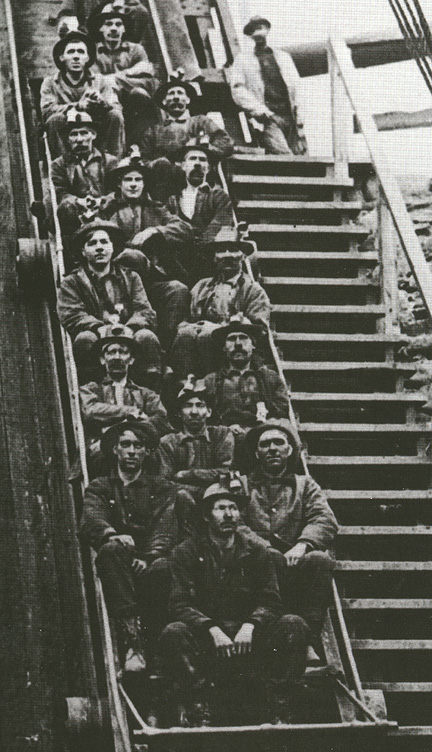
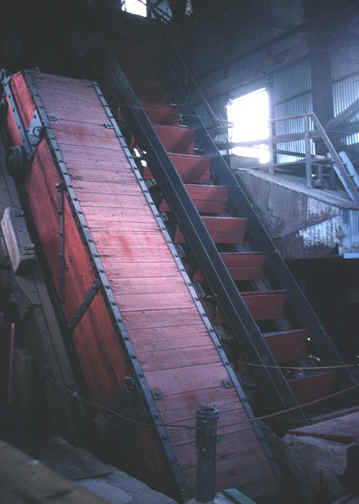
Source: Unknown Source: Photograph by Randy Schaetzl, Professor of Geography - Michigan State University
Copper mining was not only difficult work, but dangerous work as well. Miners had to work by candlelight, as shown below. Often they went about their work in total darkness, to save on oxygen that the candles were consuming. Imagine driving steel pins into rock in complete darkness--a darkness as black as the darkest night! Or better yet, image that you are holding the pin....
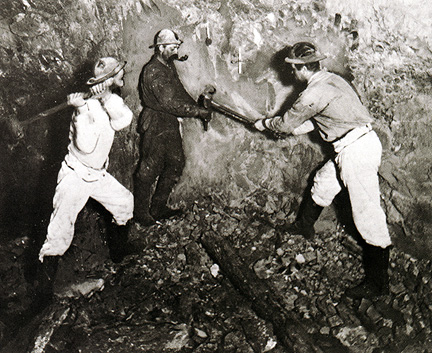
Source: Unknown
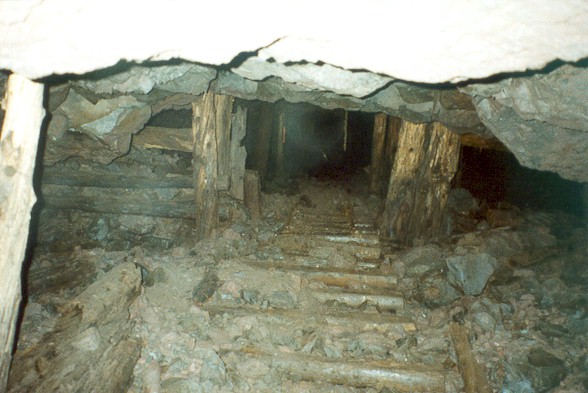
Source: Unknown
TYPICAL SHAFTS IN A COPPER
MINE
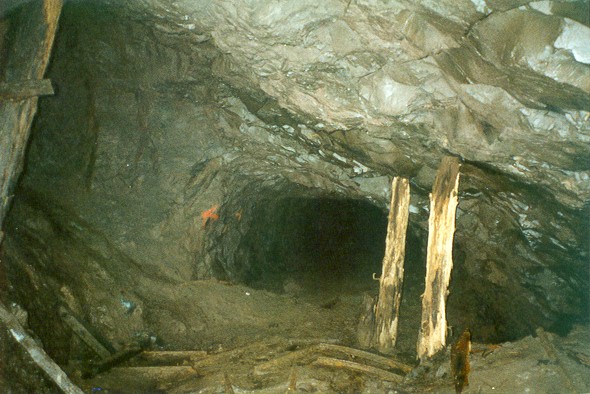
Source: Unknown
Ore was removed in two parallel shafts. The method by which the
mine is worked is simple. Much of the rock is moved through the shafts
in cars, which run on suspended wire ropes. They are so arranged that
two of theses tracks, each running to a different chute, extend from the
same ore body, or are connected so as to operate together. The one loaded
car going down draws up an empty car on the other. This arrangement facilitates
getting the ore out of the mine very easily and with a minimum of energy
expended.
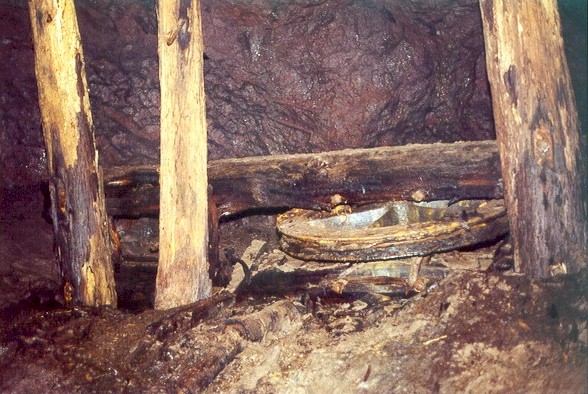
Source: Unknown
Often, early copper miners had to work in near darkness, for the excessive
use of candles would use up the limited oxygen that was in the deep mine
shafts. Note the candles on the helmets of the miners shown below.
In some instances, the miners would work in total darkness, again to preserve
the precious oxygen in the mine.
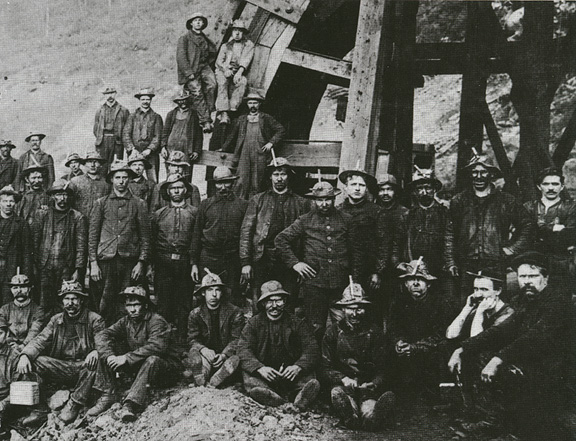
Source: Unknown
Neither was it high-paying work. Examine the Table below for evidence
of that!
Jobs, Hours and Pay in Michigan Underground Copper Mines
as of 1924
|
Job Type |
AverageHours Worked Per
Week |
Average Hourly Earnings |
Average Weekly Earnings |
| Blacksmiths (surface and underground) |
54.0 |
$.445 |
$24.03 |
| Blacksmiths' helpers (surface and underground) |
54.0 |
.354 |
19.12 |
| Carpenters (surface and underground) |
53.9 |
.425 |
22.91 |
| Carpenters' helpers (surface and underground) |
54.0 |
.363 |
19.60 |
| Chute loaders (underground) |
48.0 |
.503 |
24.14 |
| Drilling machine operators (company miners, underground) |
48.0 |
.557 |
26.74 |
| Drilling machine operators (contract miners, underground) |
48.0 |
.676 |
32.45 |
| Drivers (surface) |
54.0 |
.358 |
19.33 |
| Drivers, mule (underground) |
48.0 |
.400 |
19.20 |
| Electricians (surface and underground) |
51.7 |
.465 |
24.04 |
| Electricians' helpers (surface and underground) |
54.0 |
.368 |
19.87 |
| Engineers, stationary (surface) |
61.5 |
.420 |
25.83 |
| Firemen, stationary (surface) |
56.3 |
.426 |
23.98 |
| Hoistmen (surface) |
53.5 |
.473 |
25.31 |
| Hoistmen (underground) |
48.0 |
.428 |
20.54 |
| Laborers (underground) |
48.0 |
.474 |
22.75 |
| Loading machine operators (underground) |
48.0 |
.413 |
19.82 |
| Machinists (surface and underground) |
53.8 |
.478 |
25.72 |
| Machinists' helpers (surface and underground) |
54.0 |
.377 |
20.36 |
| Ore sorters (surface and underground) |
48.0 |
.412 |
19.78 |
| Pipemen (surface and underground) |
48.5 |
.481 |
23.33 |
| Powdermen (underground) |
48.0 |
.463 |
22.22 |
| Timbermen (underground) |
48.0 |
.464 |
22.27 |
| Timbermen's helpers (underground) |
48.0 |
.406 |
19.49 |
| Tool dressers (surface) |
54.0 |
.401 |
21.65 |
| Truck operators (surface) |
54.0 |
.383 |
20.68 |
| Watchmen (surface) |
66.3 |
.352 |
23.34 |
| Other employees (surface and underground) |
50.1 |
.497 |
24.90 |
Source: United States Bureau of Labor Statistics. Monthly Labor Review. Vol. 20, Jan-June 1925. Washington: Government Printing Office, pages1033-1039
The Pasty
The pasty (pronounced pass tee) is a traditional British foodstuff, originally developed for the tin miners of Cornwall in the far southwest of the country. A pasty consists of a circle of pastry filled with meat, potatoes and other vegetables which is then folded over to form a filled semicircular pie-like thing. Like other traditional British foods such as shepherds pie, pasties would be made the night before using local ingredients, and were handily self-contained so that they could be taken to work in the morning and eaten later on. A proper Cornish Pasty will have a very thick crust along the joined edge where the two halves of the pastry were joined together: this is because tin extraction used to require handling arsenic, and the miners used to hold the pasty by the crust and eat the filling, then throw away the arsenic-contaminated crust afterwards. They had a huge advantage in the cold, damp copper mines because the ingredients would stay warm until lunchtime, providing the miners with a welcome hot meal. They remain highly popular in the Copper Country even today.
Some of the images on this page were donated by Nate Verhanovitz, a mechanical engineering grad student at MSU.
This material has been compiled for educational use only, and may not be reproduced without permission. One copy may be printed for personal use. Please contact Randall Schaetzl (soils@msu.edu) for more information or permissions.